Source: Government of New Brunswick
Introduction
As livestock operations have intensified, farm operators can no longer depend on traditional means of watering their grazing herd. In the past, farmers pastured their cattle where they were allowed direct access to a natural source of water. Due to intensive land use and increased stocking rates, more effective watering systems are needed to protect watercourses and to improve the availability of good quality water.
To ensure good herd health status and animal performance, livestock should be kept away from streams, ponds, wetlands and ditches and alternative watering systems developed. Livestock can also damage the riparian zone by destabilizing the bed and banks of the watercourse, the vegetation , and adding pathogens and excessive nutrients to the water. Limiting access to specific points by fencing along the watercourse and stabilizing certain areas greatly reduces negative impacts. However, total exclusion from the watercourse is recommended to eliminate contamination and degradation.
Improved pasture management practices such as rotational and strip grazing require a more flexible watering alternative. The system should encourage uniform nutrient distribution over the pasture and reduce trampling and overgrazing near watering areas.
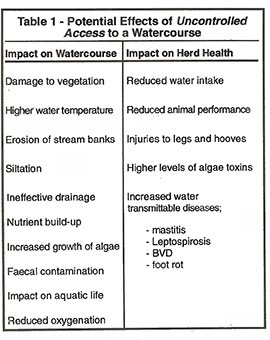
It is essential to determine water requirements when designing a new livestock watering system. Daily water consumption varies significantly with air temperature and humidity, water content of the diet, and water temperature. Although dairy cows have access to water in the barn, most of their water consumption will take place outdoors.
As farmers consider livestock watering alternatives, the following factors may need to be evaluated to see if the existing water sources can be of use.
- rate of flow
- water storage volume
- differences in elevation
- depth of water
- accessibility
Livestock operators should evaluate the cost, installation, maintenance and overflow management requirements, and environmental impact of the alternatives.
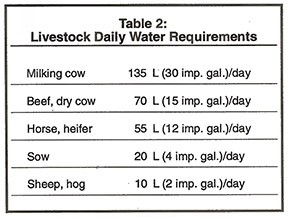
Barn Fed Watering System
In many cases, barn fed systems are the most cost-effective and flexible options farmers have. Barn fed water lines are used extensively where intensive grazing management is practiced. Multiple watering sites can eliminate the need for cattle to travel long distances for water, thereby maximizing cattle performance.
The water line diameter needs to be properly sized because there can be significant pressure loss in the line due to friction. For a herd of 50 cows, the system (water source, pump/pressure tank, delivery line, valve) should be capable of supplying 0.3 Us (4.0 imp.gpm). To achieve this, a 19 mm (3/4″) diameter pipe is generally used for lines less than 150 meters long, 25 mm (11 “) for lines of 150 to 500 meters, and 32 mm (111/4”) for lines over 500 meters. Water flow requirements are less for smaller herds.
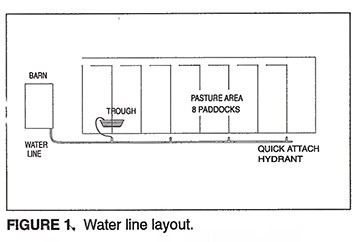
These water lines can be buried at a shallow depth to protect them from machinery, cattle, and the sun. Due to its strength, high pressure pipe is usually used to prevent collapse or other damage. Water in pipes exposed to the sun can become fairly hot. Available now, are UV-protected white plastic lines which reduce heating. However, heating of water in black plastic lines is not of great concern since vegetation establishes quickly over the water line. For convenience though, the main pipeline should be buried after farmers are satisfied with the layout.
Quick attach hydrants and portable troughs (180 L, 40 gal) are becoming popular. These small troughs must be equipped with full flow or high output valves since traditional float valves often do not allow sufficient output. Rapid water recovery is the key to making small troughs work. It is also important to install them near the grazing cattle so that they do not all move together as a group for water.
This system is easy to install and very reliable. Water lines need to be drained in the fall to avoid damage due to freezing.
Gravity Fed System
Although gravity fed watering systems have been supplying fresh water to many households in Atlantic Canada, not many systems are installed to water grazing cattle. This low cost system can be easily installed to provide water for cattle where there is sufficient grade to allow a gravity flow. Springs are the most common water sources used.
It is essential to determine both the capacity of the water supply and the difference in elevation between the water source and the proposed watering area. To prevent the occurrence of airlocks, the water line should be laid on a uniform grade. To minimize flow resistance, a pipe diameter of 32 mm (11/4″) should be used for grades over 1.0%; for grades from 1.0% down to 0.5% a 38 mm (111/2″) line is recommended. For grades less than 0.2%, gravity systems should not be used.
Watering troughs can be equipped with float valves or with an overflow mechanism. When installed correctly, gravity fed systems are very reliable and require minimal maintenance.
Pasture Pump
The pasture pump (nose pump) is livestock operated. The apparatus is activated by cattle when they push and release a lever with their muzzle. This action pumps and allows the water to enter the pump’s basin. The system requires a 25 mm (1 “) line and a foot valve.
To train cattle, exclude or remove all other water sources from the pasture and, if possible, install the pump near the previous watering area. The pump must be level so that the water does not run out of the basin. It must also be well secured so that cattle do not push it around. Cattle generally learn to use it quickly and with no difficulties.
Water can be drawn from springs, streams, ponds, or shallow wells. One pump is sufficient for 20 to 30 head of cattle, depending on pasture design. When cattle travel long distances for water, they tend to travel in groups. Since the pasture pump can only supply water to one animal at a time, problems can result.
The pasture pump can be relocated quickly and easily. For small herds this is a cost-effective watering system.
Hydraulic Ram Pump
Ram pumps are not new technology. In fact, these pumps were first used in the late 1770’s. There are many types of hydraulic ram pumps on the market today. Although they all use the force of falling water as their source of energy, they vary substantially in their design, construction materials, and capacity.
These self-activated pumps are generally set beside or in a shallow stream, located below the water intake. The pressure generated by the failing water entering the pump, compresses air in a surge tank which, subsequently, is used to push a portion of the water uphill to where it is needed. These bursts of compression are of very short duration, 25 to 100 compression per minute.
Once the system is operational and well tuned, it will supply a continuous flow of water To allow for proper tuning, it is essential that the unit be installed as specified by the manufacturers. Additional components such as valves and a stand pipe may be necessary.
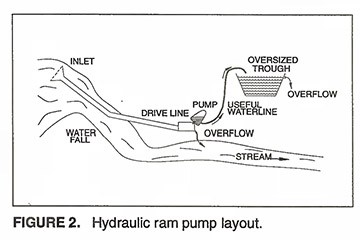
Sling pump
This technology was introduced in Canada in the early 1990’s. Though farmers have a choice between wind or water activated pumps, the version propelled by flowing water is the more effective of the two.
This floating pump is set in a slow rotation by means of a propeller, driven by running water. As it rotates, air and water alternately enter the rear of the device, and are forced through a coiled hose inside the unit and through a swivel coupling to the delivery pipe located in front of the pump. The unit is anchored to prevent it from drifting with the current.
Various models are available to suit pumping capacity requirements for pressure head and flow rate. A water velocity of 0.6 m/s (2 ft/sec) will generate adequate pumping. A minimum water depth of 25 to 40 cm (according to the model) is necessary. Removal for the winter season is obligatory.
This pumping system is easily installed, requires little maintenance, and has a low operational cost. As it is a recent technology, this pump will require further evaluation.
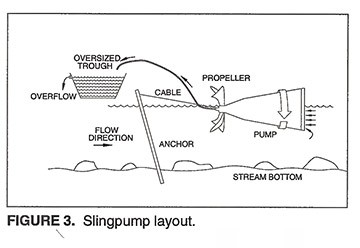
Solar Powered Pump
A photovoltaic panel converts sunlight into DC electricity which operates a pump, controlled by an electric float switch. For water supply during the night and on cloudy days, it is imperative either to use a deep cycle battery to store electricity or to store water in large quantity (in a reservoir or an oversized trough).
This system can be adapted for any cattle water requirement.
A single solar system can be shared by both a pumping unit and an electric fence energizer. Manufacturers generally prefer to custom design the system to suit the client’s needs. Installation and maintenance require some expertise.
Although not many solar powered watering systems are installed in the Maritimes they are used extensively in the western provinces. Due to its high capital cost, this system is suitable for larger herds .
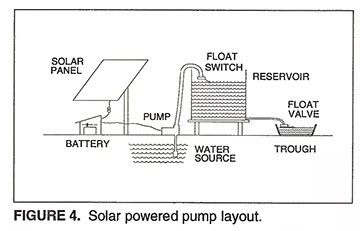
Wind Powered Pump
Windmills can be used to pump water, aerate dugouts, and generate electricity. There are two types of wind powered water pumps. The traditional reciprocating pump has the windmill situated directly over the water source. It offers the best pumping capacities, but requires periodic maintenance and part replacement.
Compressed air pumping systems are now the most commonly used because of their lower cost. This type of windmill pump compresses air which in turn, activates a pump located in the water. Water enters the pump until the floating valve rises to close the inlet opening, at which time the compressed air displaces water out of the pump and up to the trough. The air exhausted aerates the water source so that good water quality is maintained.
Because wind is a variable energy source, windmill pumping systems require sufficient water storage to maintain a constant supply of water during calm periods.
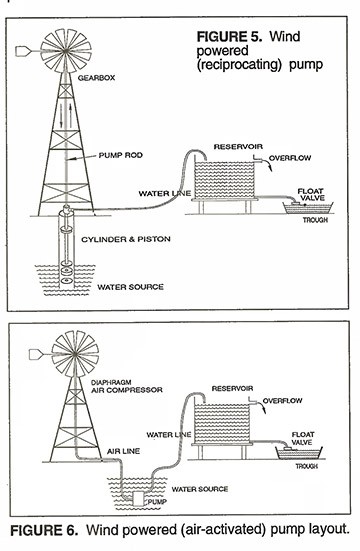
Others
Hauling water with a transportable cistern is another option farmers have. This system generally consists of a trailer mounted cistern which supplies water by gravity to a portable watering trough. The trough is fitted with a float valve. To avoid frequent handling, specially designed troughs are available which can be installed on the trailer or cistern. Transportable cisterns are well suited for intensive pasture management because the watering site can be moved to various areas of the pasture as cattle rotationally graze.
There are many reasonably priced fuel and battery activated pumps capable of satisfying different requirements. These pumps can be used to deliver water to livestock watering stations or to fill up transportable cisterns.
Transportable cisterns and portable pumps, although not very costly, are labour intensive because farmers must monitor water volumes in storage and supervise the pumping operation.
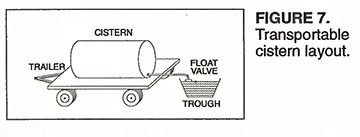
| Table 3. Livestock Watering Systems | ||||||||||
| SYSTEM | ENERGY SOURCE | WATER SUPPLY | CAPABILITY |
|
ADDITIONAL INFORMATION | |||||
| Barn fed | electrical | well, etc. | 27,000 UDay 0.3 Us (recommended) | $0 | $700+ | Very reliable. Low cost. Suitable for intensive grazing. | ||||
| Gravity fed | gravity | Spring, Drainage tile, cistern, pond | depends on water source | $0 | $700+ | Airlock problems Requires elevation surveying. Overflow management at water source and/or trough. Continuous pumping system. | ||||
| Pasture pump | livestock | Shallow Water Sources | 20 – 30 head 7 m lift or 70 m distance | $350 | $400 | Keep foot valve clean. Suitable for small herds. Low cost & maintenance. | ||||
| Hydraulic ram pump | falling water | Stream, Spring | 2,600-60,000 U Day 5-30 m lift per 1 m fall depends on model | $300- $1,000 | $1000+ | Requires a waterfall or a good slope. Detailed installation requirements. Continuous pumping system. Overflow mgt at pump & trough. | ||||
| Sling pump | flowing water (or wind) | River (lake) | 3,000-15,000 L/day 8 – 25 m lift (water powered models) | $1,000- $1,700 | $1,700+ | Requires sufficient water speed. Continuous pumping system. Overflow mgt at trough. | ||||
| Solar powered pump | sun | All | depends on design | $1,500 + | $2,200+ | Requires technical skills for installation and maintenance. Requires energy storage (battery or reservoir). | ||||
| Wind powered pump air activated” | wind | pond, shallow well, etc. | 27,000 U Day 6 m lift 300 rn distance | $1,100+ | $1,800+ | Requires some skills for installation. Requires water storage. Continuous pumping system. Overflow mgt at trough or reservoir. | ||||
| Transportable Cistern | electrical or fuel | All | depends on cistern capacity | $0+ | $1,100+ | Labour intensive. Suitable for intensive grazing. Requires good water source for fill up. | ||||
| Gas or battery powered pump | fuel or batteries | All | depends on model | $200- $900 | $900+ | Labour intensive. Requires water storage. Requires good water source for fill up. | ||||
Water Storage and Overflow Management
Some of the systems described (i.e. gravity fed, hydraulic ram, sling pump, and windmill pump) offer inadequate short term water supply to meet the needs of several animals drinking at once, but operate continuously. To ensure that water is always available, a sufficient amount must be stored in an oversized trough or a reservoir. If a reservoir is used the water can gravity feed to a trough.
Any overflow should be evacuated away from the watering area through a pipe. This will keep the site as dry as possible.
Watering Trough Information
To prevent negative environmental impact, troughs should be installed at a respectable distance away from any watercourse. Highly sloped terrains should be avoided in order to avert run off and erosion. Level ground and a well drained soil should be chosen to reduce trampling and muddy conditions.
It is always preferable to use multiple watering sites to minimize trampling and improve nutrient (manure and urine) distribution. Troughs installed at the end of a paddock opposite the entrance, will encourage cattle to graze more evenly and result in more uniform manuring. Fertilizing watering sites, alleyways, wood lots, and barnyards is not very productive. These precious nutrients should be used to stimulate forage growth.
If a single watering station is the only means to water livestock it should be situated as centrally as possible in the grazing area. Troughs installed at the end of fields or alleyways must be large enough and fitted with high output valves to satisfy many cattle drinking simultaneously. Entire herd movements and social drinking can be observed when cattle need to walk long distances (over 150 m) to the watering site. Farmers should encourage their cattle to graze rather than walk. Troughs used at a single watering station should be sized to hold one quarter of the herd’s daily water needs. Refilling should be achieved within one hour.
Before allowing cattle to enter a new grazing area, troughs should be full or else animals may show aggressive behaviour towards watering equipment.
Troughs should be emptied and rinsed regularly. This will eliminate build up of algae and other foreign material.
Summary
There are many livestock watering systems available to farmers today. Some require high capital expenditure but low operational and maintenance costs. Others are cheap to purchase and install, but may necessitate higher levels of management. Farmers, using resourcefulness and creativity, can custom design a livestock watering system according to their needs.
The preservation of watercourses through environmentally responsible management is an important part of maintaining good water quality. Farmers have come to recognize the importance of water quality for livestock and its contribution towards a successful operation.









